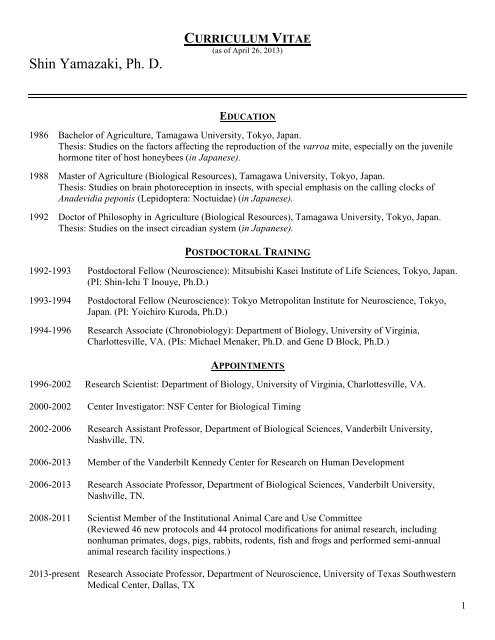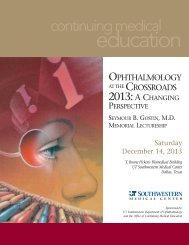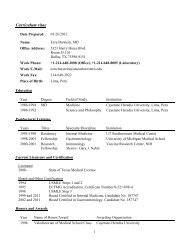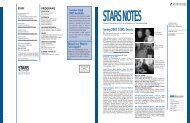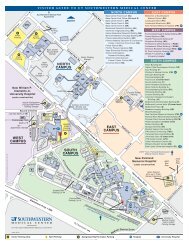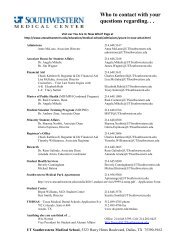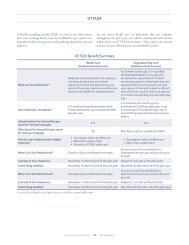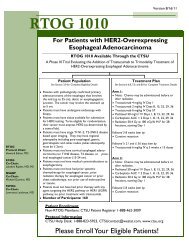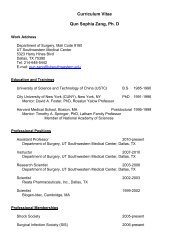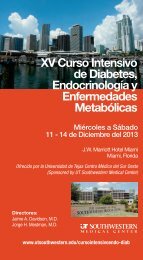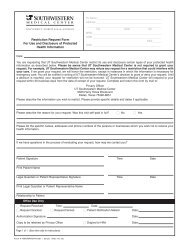CURRICULUM VITAE - UT Southwestern
CURRICULUM VITAE - UT Southwestern
CURRICULUM VITAE - UT Southwestern
You also want an ePaper? Increase the reach of your titles
YUMPU automatically turns print PDFs into web optimized ePapers that Google loves.
Shin Yamazaki, Ph. D.<br />
<strong>CURRICULUM</strong> <strong>VITAE</strong><br />
(as of April 26, 2013)<br />
EDUCATION<br />
1986 Bachelor of Agriculture, Tamagawa University, Tokyo, Japan.<br />
Thesis: Studies on the factors affecting the reproduction of the varroa mite, especially on the juvenile<br />
hormone titer of host honeybees (in Japanese).<br />
1988 Master of Agriculture (Biological Resources), Tamagawa University, Tokyo, Japan.<br />
Thesis: Studies on brain photoreception in insects, with special emphasis on the calling clocks of<br />
Anadevidia peponis (Lepidoptera: Noctuidae) (in Japanese).<br />
1992 Doctor of Philosophy in Agriculture (Biological Resources), Tamagawa University, Tokyo, Japan.<br />
Thesis: Studies on the insect circadian system (in Japanese).<br />
POSTDOCTORAL TRAINING<br />
1992-1993 Postdoctoral Fellow (Neuroscience): Mitsubishi Kasei Institute of Life Sciences, Tokyo, Japan.<br />
(PI: Shin-Ichi T Inouye, Ph.D.)<br />
1993-1994 Postdoctoral Fellow (Neuroscience): Tokyo Metropolitan Institute for Neuroscience, Tokyo,<br />
Japan. (PI: Yoichiro Kuroda, Ph.D.)<br />
1994-1996 Research Associate (Chronobiology): Department of Biology, University of Virginia,<br />
Charlottesville, VA. (PIs: Michael Menaker, Ph.D. and Gene D Block, Ph.D.)<br />
APPOINTMENTS<br />
1996-2002 Research Scientist: Department of Biology, University of Virginia, Charlottesville, VA.<br />
2000-2002 Center Investigator: NSF Center for Biological Timing<br />
2002-2006 Research Assistant Professor, Department of Biological Sciences, Vanderbilt University,<br />
Nashville, TN.<br />
2006-2013 Member of the Vanderbilt Kennedy Center for Research on Human Development<br />
2006-2013 Research Associate Professor, Department of Biological Sciences, Vanderbilt University,<br />
Nashville, TN.<br />
2008-2011 Scientist Member of the Institutional Animal Care and Use Committee<br />
(Reviewed 46 new protocols and 44 protocol modifications for animal research, including<br />
nonhuman primates, dogs, pigs, rabbits, rodents, fish and frogs and performed semi-annual<br />
animal research facility inspections.)<br />
2013-present Research Associate Professor, Department of Neuroscience, University of Texas <strong>Southwestern</strong><br />
Medical Center, Dallas, TX<br />
1
Society for Research on Biological Rhythms<br />
The Society for Neuroscience<br />
PROFESSIONAL AFFILIATIONS<br />
OTHER ACTIVITIES<br />
Editorial Board:<br />
2008-present “PLoS ONE” Academic Editor (edited and published 89 papers)<br />
2009-present “Frontiers in Molecular Neuroscience” Review Editor<br />
Grant Review:<br />
“The Netherlands Organization for Health Research and Development”, Netherlands<br />
“Medical Research Council”, UK<br />
“Biological Rhythms and Sleep” (Ad hoc NIH study section member)<br />
“Challenge Grant (NIH RFA-OD-09-003)” Special Emphasis Panel/Scientific Review Group 2009/10 ZRG1<br />
IFCN-A (58) mail reviewer.<br />
“Human Frontier Science Program” mail reviewer<br />
“NSF Neural Systems”<br />
“NIH research expert review panel” participant (compensated)<br />
Manuscript Review (total of 53) :<br />
“Proceedings of National Academy of Sciences, U.S.A.”<br />
“Journal of Neuroscience”<br />
“European Journal of Neuroscience”<br />
“Analytical Biochemistry”<br />
“Physiology and Behavior”<br />
“Journal of Comparative Physiology - A”<br />
“Journal of Physiology”<br />
“Zoological Science”<br />
“Neuroscience”<br />
“Neuroscience Letters”<br />
“Biochemical Pharmacology”<br />
“Journal of Biological Rhythms”<br />
“Stem Cells”<br />
“Genes to Cells”<br />
“PLoS ONE”<br />
“Journal of Neurophysiology”<br />
“Journal of Applied Physiology”<br />
“Chronobiology International”<br />
“American Journal of Physiology - Lung Cellular and Molecular Physiology”<br />
“American Journal of Physiology - Regulatory, Integrative and Comparative Physiology”<br />
“Journal of Visualized Experiments (JoVE)”<br />
“Biochemistry and Cell Biology”<br />
“Addiction Biology”<br />
2
Consulting:<br />
Development of the luminescence recording apparatus, LumiCycle (32-channel carousel luminescence<br />
recording device and data analysis software). The LumiCycle was produced in collaboration with Dr. David<br />
Ferster (Actimetrics Inc. Evanston IL). More than 50 of these instruments have been purchased by circadian<br />
researchers in 8 countries (USA, Japan, Switzerland, Germany, France, UK, Brazil and China) and I have<br />
personally traveled to 3 countries to perform on-site installation. I also serve as a consultant for 22 laboratories<br />
using this equipment.<br />
Outreach Program:<br />
Organization and operation of the biological clocks booth at Brain Blast in Nashville, TN. Brain Blast is a free<br />
event that promotes hands-on learning by children of all economic and racial backgrounds (2004-2013).<br />
The Research Experience for High School Students:<br />
Sponsored by the Vanderbilt Center for Science Outreach<br />
June 4-July 13, 2012<br />
Two high school students, Roya E Huang (Henry M Gunn High School, Palo Alto, CA) and William Z Yang<br />
(Montgomery Bell Academy, Nashville, TN) performed independent research projects in my lab.<br />
PATENT DISCLOSURES<br />
“Transgenic mammals introduced a Period 1 promoter that confers rhythmical expression”. Patent number:<br />
7,659,387 (granted on February 9th, 2010 by United States Patent Trademark Office)<br />
CURRENT AND COMPLETED RESEARCH SUPPORT<br />
Ongoing Research Support<br />
IOS-1146908 Yamazaki (PI) 03/01/12-02/28/15<br />
NSF<br />
Exploring the Interaction between Light- and Food-Entrainable Oscillators in the Mammalian Circadian System<br />
The major goals of this project are (i) to identify genes that are important for timekeeping in the circadian clock<br />
that controls food anticipatory activity and the clock which controls methamphetamine-induced circadian<br />
behavior; and (ii) to investigate those circadian oscillators as components of the integrated circadian circuit.<br />
Role: PI<br />
Completed Projects<br />
11GHSU138 Yamazaki (PI) 07/01/11-06/30/12<br />
MMPC/NIH<br />
Interplay between circadian disorganization and obesity<br />
The major goal of this project was to define the role of Per3 in regulating metabolism.<br />
Role: PI<br />
P30 ES000267 Guengerich (PI) 04/04/10-03/31/11<br />
NIH/NIEHS Center in Molecular Toxicology Pilot Project<br />
The effect of TCDD on the circadian gene expression rhythm in mammalian pacemakers.<br />
Role: PI<br />
R01 NS051278 Yamazaki (PI) 06/01/05-05/31/10 NIH/NINDS<br />
Effect of Temperature on the Mammalian Circadian System.<br />
The major goals of this project were to characterize the effect of temperature on the circadian rhythm in central<br />
and peripheral tissues.<br />
3
Role: PI<br />
R01 EY015815 McMahon (PI) 07/01/04-10/31/08<br />
NIH/NEI<br />
Circadian Organization of the Retina.<br />
The major goals of this project were to define the circadian function in the retinal dopaminergic neuron.<br />
Role: Collaborator<br />
(my support was terminated on 10/31/08 by PI)<br />
R01 MH075016 de la Iglesia (PI) 04/01/06-03/31/08<br />
NIH/NIMH<br />
Forced Desynchronization of the Rat Circadian System.<br />
The goal of this project was to understand the coordination of circadian-regulated physiological outputs of the<br />
brain pacemaker in the suprachiasmatic nucleus.<br />
Role: Collaborator<br />
(subcontract was terminated on 3/31/08 by PI)<br />
Research Grant Yamazaki (PI) 12/22/06-12/21/09<br />
Research Foundation for Opto-Science and Technology<br />
Use of luminescence reporters for circadian characterization of lung tumors.<br />
The major goals of this project are to define the circadian function in tumor progression.<br />
Role: PI<br />
4
MENTORING<br />
Judong Lee: 2005<br />
Degree: MS<br />
Current Position: PhD candidate, University of Pittsburgh<br />
Mijung Yeom, PhD: 2007-2009<br />
Current Position: Research Professor, Acupuncture and Meridian Science Research (AMSRC)<br />
Kyung Hee University, Seoul, Korea<br />
Julie S. Pendergast, PhD: 2007-2012<br />
Current Position: Instructor, Division of Diabetes, Endocrinology and Metabolism, Department of Medicine,<br />
Vanderbilt University<br />
TEACHING AND UNDERGRADUATE RESEARCH MENTORSHIP<br />
Department of Biological Sciences,<br />
Vanderbilt University<br />
BSCI 230 Biological Rhythms<br />
(Guest lecture)<br />
Fall 2005; 2006<br />
BSCI 332 Seminar in Biological Rhythms<br />
(Organizer)<br />
Spring 2006-Fall 2011<br />
BSCI 282 Independent Reading<br />
Aaron J Shambley, Fall 2008<br />
Harish Krishnamoorthi, Spring 2009<br />
Joshua R Mastin, Spring 2010<br />
BSCI 280 Research Internship<br />
Swati Midha, Fall 2006<br />
Alexandra Belenky, Fall 2006<br />
Ester Lee, Spring 2007 and Spring 2008<br />
Natalie Deanna Thoni, Fall 2009 and Spring<br />
2010<br />
BSCI 283 Directed Laboratory Research<br />
Wendi Bond, Fall 2003<br />
Jalin Liu, Summer 2004<br />
Julie C Wang, Fall 2004<br />
R Anjali Kumbla, Fall 2005<br />
Rio C Friday, Fall 2007<br />
Charles D Keil, Spring 2008<br />
E Jean Pak, Fall 2008<br />
Cathya Olivas, Spring 2009<br />
Matthew L Sundermann, Spring 2010<br />
BSCI 286 Independent Laboratory<br />
Research<br />
Wendi Bond, Spring 2004<br />
Jalin Liu, Fall 2004<br />
Julie C Wang, Spring 2005 and Spring 2006<br />
R Anjali Kumbla, Spring 2006<br />
Rio C Friday, Fall 2008 and Spring 2009<br />
Charles D Keil, Fall 2008<br />
Cathya Olivas, Fall 2009<br />
BSCI 296 Honors Research<br />
R Anjali Kumbla, Fall 2006 – Spring 2007<br />
Neuroscience Program<br />
NSC 292 Undergraduate Research<br />
Derrick Choi, Spring 2004- Spring 2005<br />
Bryan A Reyes, Fall 2005 – Spring 2006<br />
Amy C-R Ly, Fall 2005 – Fall 2006<br />
Alexandra Belenky, Spring 2007<br />
Meredith L Barbour, Spring 2007 – Spring<br />
2008<br />
NSC 296 Honors Research<br />
Bryan A Reyes, Fall 2006 – Spring 2007<br />
Vanderbilt University Summer Research<br />
Program<br />
Bryan A Reyes, Summer 2006<br />
Rio C Friday, Summer 2008<br />
Vanderbilt Molecular and Cellular Biology<br />
Program<br />
Derrick Choi, Summer 2004<br />
5
INVITED SEMINARS AND SYMPOSIA<br />
May 23 (2012) 13 th Biannual Meeting Society for Research on Biological Rhythms, Destin, FL<br />
Workshop SCN Architecture<br />
May 22 (2012) 13 th Biannual Meeting Society for Research on Biological Rhythms, Destin, FL<br />
Symposium 13 Circadian Organization and Peripheral Oscillators “Beyond None-Canonical Rhythmicity:<br />
Period Determination in the Food-Entrainable and Methamphetamine-Sensitive Circadian Oscillator(s)”<br />
November 21 (2011) Department of Psychiatry, McGill University, Douglas Mental Health University<br />
Institute, Montreal, Canada. “Distinct Roles of the Three Period Genes in the Mammalian Clockworks”<br />
November 22 (2010) Department of Psychophysiology, National Institute of Mental Health, National Center<br />
of Neurology & Psychiatry, Tokyo Japan. “Distinct functions of the Period genes in the mammalian circadian<br />
system: Evidence from in vitro and in vivo studies”.<br />
November 20 (2010) The 17 th Annual Meeting of the Japanese Society for Chronobiology, Tokyo Japan.<br />
“Distinct function of Period 1, 2, 3 and in vivo factors”.<br />
November 18 (2010) TARA Center, Tsukuba University, Tsukuba Japan. “Cell Cycle and Circadian Rhythm”.<br />
April 16 (2010) Biology Department, University of Massachusetts Amherst, Amherst MA. “In vitro vs. in vivo<br />
approaches: revealing the complex organization of the mammalian circadian system”.<br />
February 11 (2010) The Department of Neuroscience, University of Texas <strong>Southwestern</strong> Medical Center,<br />
Dallas TX. “In vitro vs. in vivo approaches: revealing the complex organization of the mammalian circadian<br />
system”.<br />
December 10 (2009) The 32th Annual Meeting of the Molecular Biology Society of Japan, Yokohama Japan.<br />
“Circadian-independent cell mitosis in rat1 fibroblasts”. Symposium: Integrated Regulation of Biological<br />
Cycles; Organizers: Hisao Masai, Steve McKnight, Hijime Tei<br />
October 14 (2009) Physiology Seminar, University of Kentucky, Lexington KY. “Complex organization of the<br />
mammalian circadian system: luminescence<br />
reporter techniques now and then”.<br />
February 23 (2007) Neuroscience Institute Seminar, Neuroscience Institute, Morehouse School of Medicine,<br />
Atlanta, GA. “Luminescence Reporting Technique for Biological Clock Research.”<br />
December 12 (2006) Department seminar, Dept. of Biophysics and Biochemistry, Graduate School of Science,<br />
The University of Tokyo, Tokyo, Japan. “Hierarchical Structure of Central and Peripheral Clocks in Mammals<br />
Revealed by Real-Time Luminescence Reporting Technology.”<br />
December 11 (2006) Seminar, Consolidated Research Institute for Advanced Science and Medical Care,<br />
Waseda University, Tokyo, Japan. “Mammalian Circadian System.”<br />
December 8 (2006) The Molecular Biology Society of Japan 2006 Forum: Molecular Biology – the Next<br />
Decade, Symposium, “Dynamic Regulation of Biological Clock : Molecular Orchestration and Systems”<br />
(organized by Yagita and Tei). “Luminescence reporter techniques have uncovered complexity among<br />
oscillatory structures in the mammalian circadian system.”<br />
6
December 7 (2006) Department seminar, Graduate School of Bioagricultural Sciences and School of<br />
Agricultural Sciences, Nagoya University, Nagoya, Japan. “Hierarchical Structure of Central and Peripheral<br />
Clocks in Mammals Revealed by Real-Time Luminescence Reporting Technology.”<br />
March 31 (2006) Mitsubishi Kagaku Institute for Life Sciences, Tokyo, Japan<br />
“Luminescence reporter techniques have uncovered complexity among oscillatory<br />
structures in the mammalian circadian system.”<br />
March 28 (2006) The 83 rd Annual Meeting of the Physiological Society of Japan, Maebashi, Japan.<br />
“Luminescence reporter techniques have uncovered complexity among oscillatory<br />
structures in the mammalian circadian system.” Plenary Symposium for IUPS 2009<br />
Temporal Organization of Physiology and Behaviors - Functions of<br />
Multi-oscillatory Hierarchical System (Organized by Ken-ichi Honma)<br />
May 12 (2005) Department of Biological Sciences, University of Manchester, UK<br />
“Circadian Bioluminescence Recordings from Cultured Mammalian Cells.”<br />
March 18 (2004) Department seminar, Vanderbilt University.<br />
“Suprachiasmatic Nucleus: Ringmaster of the Circadian Circus or Conductor of the Circadian Orchestra?”<br />
October 24 (2003) Waseda University, Tokyo, Japan. “Hierarchical Structure of Central and Peripheral Clocks<br />
in Mammals Revealed by Real-Time Luminescence Reporting Technology.”<br />
October 22 (2003) Electron Tube Division, Hamamatsu Photonics KK, Hamamatsu, Japan. “Real-Time<br />
Luminescence Reporting Technology for Chronobiology.”<br />
October 20 (2003) RITSU Seminar, Yamaguchi University, Yamaguchi, Japan. “Hierarchical Structure of<br />
Central and Peripheral Clocks in Mammals Revealed by Real-Time Luminescence Reporting Technology.”<br />
October 18 (2003) The 76 th Annual Meeting of the Japanese Biochemical Society, Yokohama, Japan.<br />
“Ontogeny of Circadian Organization in Rat.”<br />
October 16 (2003) Clock Cell Biology Group, National Institute of Advanced Industrial Science and<br />
Technology Center, Tsukuba, Japan. “Hierarchical Structure of Central and Peripheral Clocks in Mammals<br />
Revealed by Real-Time Luminescence Reporting Technology.”<br />
September 9-12 (2003) 1st World Congress of Chronobiology. Sapporo, Japan. “Effect of Temperature on the<br />
Mammalian Circadian System.”<br />
June 26-30 (2002) Society for Behavioral Neuroendocrinology Annual Meeting. Amherst, MA, USA.<br />
“Ontogeny of Circadian Organization in Rat.”<br />
May 25 (2002) Eighth Meeting Society for Research on Biological Rhythms, Jacksonville, FL. “Luciferase<br />
imaging of circadian function.”<br />
August 9 (2001) Gordon Research Conference: Chronobiology. Salve Regina University, Rode Island.<br />
“Chronoarchitecture: hierarchical structure of central and peripheral clocks in mammals.”<br />
June 26 (2001) Department of Neurobiology and Physiology, Northwestern University, Evanston IL.<br />
“Disruption of Circadian Organization in Jet-Lagged Transgenic Rats.”<br />
7
December 18 (2000) U.S.-Japan Symposium on Molecular Mechanism for Circadian Clocks: Functions of<br />
Clock Genes. Kyoto Japan. “Coupling between the Right and Left SCN.”<br />
April 14 (2000) Friday At Four!, University of Virginia, Charlottesville, VA, USA. “Disruption of Circadian<br />
Organization in Jet-Lagged Transgenic Rats.”<br />
June 10 (1998) Morehouse School of Medicine Neuroscience Institute, Atlanta, GA, USA. “How Does SCN<br />
Control Nocturnal Activity in a Hamster?”<br />
December 9 (1997) Stanford University Sleep Research Center, Stanford, CA, USA. “How Does SCN Control<br />
Nocturnal Activity in a Hamster?”<br />
December 4-6 (1997) Japan-US conference on molecular chronobiology, San Francisco, CA. USA. “How<br />
Does SCN Control Nocturnal Activity in a Hamster?”<br />
May 9 (1997) Friday At Four!, University of Virginia, Charlottesville, VA, USA. “Circadian Organization in<br />
the Brain of Hamsters: Circadian Rhythms, Ultradian Rhythms, SCN, BNST, Hb, Retina, LSN; How Can I Put<br />
Together the Pieces of This Puzzle?”<br />
October 4 (1993) Yamagata University School of Medicine, Yamagata, Japan. “Mechanisms of the Circadian<br />
Oscillation in Mammalian SCN.”<br />
MEETING CO-ORGANIZATION<br />
Rhythms In the South Eastern Region Site for 2011 (RISER 2011)<br />
May 14-15, 2011, 59 attendees<br />
Rhythms In the South Eastern Region Site for 2009 (RISER 2009)<br />
May 16, 2009, 64 attendees<br />
8
Bibliography:<br />
PEER-REVIEWED PRIMARY PUBLICATIONS (TOTAL OF 60):<br />
Pendergast JS, Branecky KL, Yang W, Ellacott KL, Niswender KD, Yamazaki S (2013)<br />
High-fat diet acutely affects circadian organisation and eating behavior. Eur J Neurosci. doi:<br />
10.1111/ejn.12133.<br />
Pendergast JS, Oda GA, Niswender KD, Yamazaki S (2012) Period determination in the food-entrainable and<br />
methamphetamine-sensitive circadian oscillator(s). Proc Natl Acad Sci U S A. 109:14218-14219. PMCID:<br />
PMC3435193[Available on 2013/2/28]<br />
Pendergast JS, Yamazaki S (2012) The Mammalian Circadian System is Resistant to Dioxin.<br />
J Biol Rhythms 27:156-163. PMCID: PMC3337685<br />
Pendergast JS, Niswender KD, Yamazaki S (2012) Tissue-Specific Function of Period3 in Circadian<br />
Rhythmicity. PLoS ONE 7(1): e30254. doi:10.1371/journal.pone.0030254. PMCID: PMC3256228<br />
Pendergast JS, Yamazaki S (2011) Masking Responses to Light in Period Mutant Mice.<br />
Chronobiol Int. 28:657-663.<br />
Nakamura TJ, Nakamura W, Yamazaki S, Kudo T, Cutler T, Colwell CS, Block GD (2011) Age-related<br />
decline in circadian output. J Neurosci. 31:10201-10205. PMCID: PMC3155746<br />
Um JH, Pendergast JS, Springer DA, Foretz M, Viollet B, Brown A, Kim MK, Yamazaki S, Chung JH (2011)<br />
AMPK Regulates Circadian Rhythms in a Tissue- and Isoform-Specific Manner. PLoS One 6(3):e18450.<br />
PMCID: PMC3069094<br />
Pendergast JS, Yeom M, Reyes BA, Ohmiya Y, Yamazaki S (2010) Disconnected circadian and cell cycles in a<br />
tumor-driven cell line. Commun Integr Biol. 3:536-539. PMCID: PMC3038057<br />
Pendergast JS, Friday RC, Yamazaki S (2010) Photic Entrainment of Period Mutant Mice is Predicted from<br />
Their Phase Response Curves. J Neurosci. 30:12179-84. PMCID: PMC2943870<br />
Yeom M, Pendergast JS, Ohmiya Y, Yamazaki S (2010) Circadian-independent cell mitosis in immortalized<br />
fibroblasts. Proc Natl Acad Sci U S A. 107:9665-9670.<br />
PMCID: PMC2906903<br />
Shi S, Hida A, McGuinness OP, Wasserman DH, Yamazaki S, Johnson CH (2010) Circadian Clock Gene<br />
Bmal1 Is Not Essential; Functional Replacement with its Paralog, Bmal2.<br />
Curr Biol. 20: 316-21. PMCID: PMC2907674<br />
Pendergast JS, Friday RC, Yamazaki S (2010) Distinct Functions of Period2 and Period3 in the Mouse<br />
Circadian System Revealed by In Vitro Analysis. PLoS ONE 5(1): e8552. doi:10.1371/journal.pone.0008552.<br />
PMCID: PMC2804141<br />
Pendergast JS, Friday RC, Yamazaki S (2009) Endogenous Rhythms in Period1 Mutant Suprachiasmatic<br />
Nuclei In Vitro Do Not Represent Circadian Behavior. J Neurosci 29:14681-14686. PMCID: PMC2806308<br />
9
Pendergast JS, Nakamura W, Friday RC, Hatanaka F, Takumi T, Yamazaki S (2009) Robust food anticipatory<br />
activity in BMAL1-deficient mice. PLoS ONE 4(3):e4860. PMCID: PMC2654093<br />
Yamazaki S, Yoshikawa T, Biscoe EW, Numano R, Gallaspy LM, Soulsby S, Papadimas E, Pezuk P, Doyle<br />
SE, Tei H, Sakaki Y, Block GD, Menaker M (2009) Ontogeny of Circadian Organization in the Rat. J Biol<br />
Rhythms 24:55-63. PMCID: PMC2665126<br />
Mistlberger RE, Yamazaki S, Pendergast JS, Landry GJ, Takumi T, Nakamura W (2008) Comment on<br />
"Differential rescue of light- and food-entrainable circadian rhythms". Science 322:675. PMCID: PMC2583785<br />
Ruan GX, Allen GC, Yamazaki S, McMahon DG (2008) An autonomous circadian clock in the inner mouse<br />
retina regulated by dopamine and GABA. PLoS Biol 6(10):e249. PMCID: PMC2567003<br />
Hiler DJ, Bhattacherjee A, Yamazaki S, Tei H, Geusz ME (2008) Circadian mPer1 Gene Expression in<br />
Mesencephalic Trigeminal Nucleus Cultures. Brain Res 1214:84-93.<br />
Akashi M, Hayasaka N, Yamazaki S, Node K (2008) Mitogen-Activated Protein Kinase Is a Functional<br />
Component of the Autonomous Circadian System in the Suprachiasmatic Nucleus. J Neurosci 28: 4619-4623.<br />
PMCID: PMC2440636<br />
Kusanagi H, Hida A, Satoh K, Echizenya M, Shimizu T, Pendergast JS, Yamazaki S, Mishima K (2008)<br />
Expression profiles of ten circadian clock genes in human peripheral blood mononuclear cells. Neurosci Res<br />
61: 136-142.<br />
Nakamura W, Yamazaki S, Nakamura TJ, Shirakawa T, Block GD, Takumi T (2008) In vivo monitoring of<br />
circadian timing in freely moving mice. Current Biol 18: 381-385.<br />
Davidson AJ, Yamazaki S, Arble DM, Menaker M, Block GD (2008) Resetting of central and peripheral<br />
circadian oscillators in aged rats. Neurobiology of Aging 29:471-477. PMCID: PMC1635489<br />
Reyes BA, Pendergast JS, Yamazaki S (2008) Mammalian Peripheral Circadian Oscillators are Temperature<br />
Compensated. J Biol Rhythms 23:95-98. PMCID: PMC2365757<br />
Um JH, Yang S, Yamazaki S, Kang H, Viollet B, Chung JH (2007) Activation of AMPK with diabetes drug<br />
metformin induces CKIe-dependent degradation of clock protein mPer2. J Biol Chem 282:20794-20798.<br />
Davidson AJ, Sellix MT, Daniel J, Yamazaki S, Menaker M, Block GD (2006) Chronic Jet-lag increases<br />
mortality in aged mice. Current Biol 16:R914-916. PMCID: PMC1635966<br />
Ruan G, Zhang D-Q, Zhou T, Yamazaki S and McMahon DG (2006) Circadian Organization of the<br />
Mammalian Retina. Proc Natl Acad Sci USA 103:9703-9708. PMCID: PMC1480470<br />
Numano R, Yamazaki S, Umeda N, Samura T, Sujino M, Takahashi RI, Ueda M, Mori A, Yamada K, Sakaki<br />
Y, Inouye SIT, Menaker M, Tei H (2006) Constitutive Expression of the Period1 Gene Impairs Behavioral and<br />
Molecular Circadian Rhythms. Proc Natl Acad Sci USA 103:3716-3721. PMCID: PMC1450145<br />
Yoshikawa T, Yamazaki S, Menaker M (2005) Effects of preparation time on phase of cultured tissues reveal<br />
complexity of circadian organization. J Biol Rhythms 20: 500-512. PMCID: PMC1470468<br />
Nakamura W, Yamazaki S, Takasu NN, Mishima K, Block GD (2005) Differential response of Per1<br />
expression within the suprachiasmatic nucleus. J Neurosci 25: 5481-5487.<br />
10
Fukuhara C, Yamazaki S, Liang, J (2005) Pineal circadian clocks gate arylalkylamine. J Neurochem 93: 156-<br />
162.<br />
Yoo SH, Ko C, Lowrey P, Buhr E, Song E-J, Chang S, Yoo O, Yamazaki S, Lee C, Takahashi JS (2005) A<br />
Novel E-box Enhancer Drives Mouse Period2 Circadian Oscillations in vivo. Proc Natl Acad Sci USA 102:<br />
2608-2613. PMCID: PMC548324<br />
Ohta H, Yamazaki S, McMahon DG (2005) Constant light desynchronizes mammalian clock neurons. Nat<br />
Neurosci 8: 267-269.<br />
Aton SJ, Block GD, Tei H, Yamazaki S, Herzog ED (2004) Plasticity of circadian behavior and the<br />
suprachiasmatic nucleus following exposure to Non-24 hour light cycles. J Biol Rhythms 19: 198-207.<br />
Yoo S-H, Yamazaki S, Lowrey PL, Shimomura K, Ko CH, Buhr ED, Siepka SM, Hong H-K, Oh WJ, Yoo OJ,<br />
Menaker M, Takahashi JS (2004) PERIOD2::LUCIFERASE real-time reporting of circadian dynamics reveals<br />
persistent circadian oscillations in mouse peripheral tissues. Proc Natl Acad Sci USA 101: 5339-5346. PMCID:<br />
PMC397382<br />
Izumo M, Johnson CH, Yamazaki S (2003) Circadian gene expression in mammalian fibroblasts revealed by<br />
real-time luminescence reporting: temperature compensation and damping. Proc Natl Acad Sci USA 100:<br />
16089-16094. PMCID: PMC307697<br />
Vansteensel MJ, Yamazaki S, Albus H, Deboer T, Block GD, Meijer JH (2003) Dissociation between circadian<br />
Per1 and neuronal and behavioral rhythms following a shifted environmental cycle. Curr Biol 13: 1538-1542.<br />
Davidson AJ, Poole AS, Yamazaki S, Menaker M (2003) Is the food-entrainable circadian oscillator in the<br />
digestive system? Genes Brain Behav 2: 32-39.<br />
Yamazaki S, Straume M, Tei H, Sakaki Y, Menaker M, Block GD (2002) Effects of aging on central and<br />
peripheral mammalian clocks. Proc Natl Acad Sci USA 99: 10801-10806. PMCID: PMC125050<br />
Yamazaki S, Alones V, Menaker M (2002) Interaction of retina with suprachiasmatic pacemakers in the<br />
control of circadian behavior. J Biol Rhythms 17: 315-329.<br />
Davidson AJ, Stokkan K-A, Yamazaki S, Menaker M (2002) Food-anticipatory activity and liver Per1-<br />
luciferase expression in diabetic transgenic rats. Physiol Behav 76: 21-26.<br />
Abe M, Herzog ED, Yamazaki S, Straume M, Tei H, Sakaki Y, Menaker M, Block GD (2002) Circadian<br />
rhythms in isolated brain regions. J Neurosci 22: 350-356.<br />
Wilsbacher LD, Yamazaki S, Herzog ED, Song EJ, Radcliffe LA, Abe M, Block G, Spitznagel E, Menaker M,<br />
Takahashi JS (2002) Photic and circadian expression of luciferase in mPeriod1-luc transgenic mice in vivo.<br />
Proc Natl Acad Sci USA 99: 489-494. PMCID: PMC117587<br />
Stokkan K-A, Yamazaki S, Tei H, Sakaki Y and Menaker M (2001) Entrainment of the circadian clock in the<br />
liver by feeding. Science 291: 490-493.<br />
Yamazaki S, Numano R, Abe M, Hida A, Takahashi RI, Ueda M, Block GD, Sakaki Y, Menaker M and Tei H<br />
(2000) Resetting central and peripheral circadian oscillators in transgenic rats. Science 288: 682-685.<br />
11
Lowrey PL, Shimomura K, Antoch MP, Yamazaki S, Zemenides PD, Ralph MR, Menaker M and Takahashi JS<br />
(2000) Positional syntenic cloning and functional characterization of the mammalian circadian mutation tau.<br />
Science 288: 483-491.<br />
Miranda-Anaya M, Bartell PA, Yamazaki S and Menaker M (2000) Circadian rhythms of ERG in Iguana<br />
iguana: role of the pineal. J Biol Rhythms 15: 163-171.<br />
Yamazaki S, Goto M and Menaker M (1999) No evidence for extraocular photoreceptors in the circadian<br />
system of the Syrian hamster. J Biol Rhythms 14: 197-201.<br />
Yamazaki S, Alones V, Irelan W and Menaker M (1999) Serotonin-containing cell bodies in novel brain<br />
locations: effects of light input. NeuroReport 10: 431-435.<br />
Yamazaki S, Kerbeshian MC, Hocker CG, Block GD and Menaker M (1998) Rhythmic properties of the<br />
hamster suprachiasmatic nucleus in vivo. J Neurosci 18: 10709-10723.<br />
Shimomura K, Kornhauser JM, Wisor JP, Umezu T, Yamazaki S, Ihara NL, Takahashi JS and Menaker M<br />
(1998) Circadian behavior and plasticity of light-induced c-fos expression in SCN of tau mutant hamsters. J<br />
Biol Rhythms 13: 305-314.<br />
Yamazaki S, Mizuno M and Sasaki M (1995) Relationships between bilateral circadian pacemakers in intact<br />
and neurally separated optic-lobes of a carabid beetle. Appl Entomol Zool 30: 537-542.<br />
Yamazaki S, Inouye SIT and Kuroda Y (1995) TTX-resistant Ca2+ oscillation in cultured hypothalamus:<br />
similarity to the mammalian circadian pacemaker. NeuroReport 6: 1306-1308.<br />
Yamazaki S, Ishida Y and Inouye SIT (1994) Circadian rhythms of adenosine triphosphate contents in the<br />
suprachiasmatic nucleus, anterior hypothalamic area and caudate putamen of the rat: negative correlation with<br />
electrical activity. Brain Res 664: 237-240.<br />
Yamazaki S, Maruyama M, Cagampang FRA and Inouye SIT (1994) Circadian fluctuations of cAMP content<br />
in the suprachiasmatic nucleus and anterior hypothalamus of the rat. Brain Res 651: 329-331.<br />
Cagampang FRA, Yamazaki S, Otori Y and Inouye SIT (1993) Serotonin in the raphe nuclei: regulation by<br />
light and an endogenous pacemaker. NeuroReport 4: 49-52.<br />
Otori Y, Cagampang FRA, Yamazaki S, Inouye SIT, Mano T and Tano Y (1993) Circadian rhythm of<br />
neuropeptide Y-like immunoreactivity in the iris-ciliary body of the rat. Current Eye Res 12: 803-807.<br />
Otori Y, Tominaga K, Fukuhara C, Yang J, Yamazaki S, Cagampang FRA, Okamura H and Inouye SIT (1993)<br />
Substance P-like immunoreactivity in the suprachiasmatic nucleus of the rat. Brain Res 619: 271-277.<br />
Yamazaki S (1992) Entrainment of the larval locomotor activity rhythm of a carabid beetle, Carabus insulicola<br />
insulicola (Coleoptera: Carabidae) to T21 and T24 cycles and after-effects on free-running period. Jpn J Appl<br />
Entomol Zool 36: 169-175. in Japanese<br />
Yamazaki S and Yamashita S (1991) Efferent control in the ocellus of a noctuid moth. J Comp Physiol A 169:<br />
647-652.<br />
12
Sasaki M, Yamazaki S and Chiba K (1987) Brain photoreception in the calling rhythm of a noctuid moth,<br />
Anadevidia peponis: method of making eyeless moth and micro-irradiation of brain with fiber optics. Bulletin<br />
of the Faculty of Agriculture, Tamagawa University 27: 81-90. in Japanese<br />
REVIEW ARTICLES AND BOOK CHAPTERS (TOTAL OF 12):<br />
Yamazaki S (2012) Peripheral Circadian Clocks. Dojin Bioscience 02 Chronobiology (Ebihara S and<br />
Yoshimura T ed) Kagaku Dojin Co (Kyoto, Japan) 80-90.<br />
Yamazaki S (2011) Peripheral Clocks. Japanese Journal of Sleep Medicine 5:55-61. in Japanese<br />
Yamazaki S, Takahashi JS (2005) Real-time luminescence reporting of circadian gene expression in mammals.<br />
Methods Enzymol 393: 288-301.<br />
Davidson AJ, Yamazaki S, Menaker M (2003) SCN: Ringmaster of the circadian circus or conductor of the<br />
circadian orchestra? Novartis Found Symp 253: 89-99.<br />
Yamazaki S (2003) Oscillation mechanisms of the circadian rhythms. Brain Medical 15: 125-132. in Japanese<br />
Yamazaki S (2001) “Chronoarchitecture”, hierarchical structure of central and peripheral clocks in mammals.<br />
Japanese Society for Chronobiology 7(2): 5-12. in Japanese<br />
Yamazaki S, Tei H (2000) Clock genes in mice and humans. In: Molecular Biology in Behavior (Yamamoto<br />
D ed) Springer (Tokyo, Japan) 111-126 in Japanese<br />
Yamazaki S (2000) Neural activity in the SCN. Clinical Neuroscience 18: 1143-1146. in Japanese<br />
Yamazaki S (1999) Neural activity in the hamster SCN. J Clinical and Experimental Medicine 190: 285-286.<br />
in Japanese<br />
Yoshida T, Sasaki M and Yamazaki S (1995) Parasitism and reproduction of Varroa mite on the Japanese<br />
honeybee, Apis cerana japonica. In: The Asiatic Hive Bee: Apiculture, Biology, and Role in Sustainable<br />
Development in Tropical and Subtropical Asia (Kevan PG ed) Enviroquest Ltd (Ontario, CANADA) pp171-<br />
175.<br />
Inouye SIT, Shinohara K, Tominaga K, Takeuchi J, Nagasaki H, Isobe Y, Fukuhara C, Otori Y, Yang J,<br />
Cagampang FRA, Yamazaki S and Tokumasu A (1993) Circadian rhythms in peptides and their precursor<br />
messenger RNAs in the suprachiasmatic nucleus. In: New Functional Aspects of the Suprachiasmatic Nucleus<br />
of the Hypothalamus (Nakagawa H, Oomura Y and Nagai K eds) John Libbey & Company Ltd, pp219-233.<br />
Yamazaki S and Inouye SIT (1993) Oscillatory mechanisms of the circadian rhythm. Brain Medical 5: 267-<br />
273 (in Japanese).<br />
13


